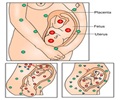A versatile platform to simultaneously offer contraception and prevent HIV has been developed by researchers.

Electrically spun cloth with nanometre-sized fibres can dissolve to release drugs, providing a platform for cheap, discrete and reversible protection.
"Our dream is to create a product women can use to protect themselves from HIV infection and unintended pregnancy," Kim Woodrow, corresponding author from the University of Washington, said.
"We have the drugs to do that. It's really about delivering them in a way that makes them more potent, and allows a woman to want to use it," Woodrow said.
Electrospinning uses an electric field to catapult a charged fluid jet through air to create very fine, nanometre-scale fibres. The fibres can be manipulated to control the material's solubility, strength and even geometry.
Due to this versatility, fibres may be better at delivering medicine than existing technologies such as gels, tablets or pills. No high temperatures are involved, so the method is suitable for heat-sensitive molecules. The fabric can also incorporate large molecules, such as proteins and antibodies that are hard to deliver through other methods.
They first dissolved polymers approved by the Food and Drug Administration and antiretroviral drugs used to treat HIV to create a gooey solution that passes through a syringe. As the stream encounters the electric field it stretches to create thin fibres measuring 100 to several thousand nanometres that whip through the air and eventually stick to a collecting plate.
"This method allows controlled release of multiple compounds," Ball said.
"We were able to tune the fibres to have different release properties," Ball said.
One of the fabrics they made dissolves within minutes, potentially offering users immediate, discrete protection against unwanted pregnancy and sexually transmitted diseases.
Another dissolves gradually over a few days, providing an option for sustained delivery, more like the birth-control pill, to provide contraception and guard against HIV.
The fabric could incorporate many fibres to guard against many different sexually transmitted infections, or include more than one anti-HIV drug to protect against drug-resistant strains and discourage drug-resistant strains from emerging.
Mixed fibres could be designed to release drugs at different times to increase their potency, like the prime-boost method used in vaccines.
The electrospun cloth could be inserted directly in the body or be used as a coating on vaginal rings or other products.
The study has been published in the journal PLoS One.
Source-ANI
 MEDINDIA
MEDINDIA




 Email
Email










